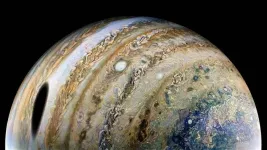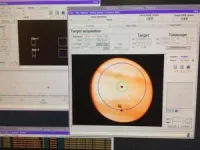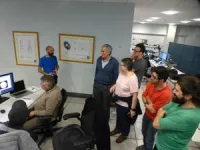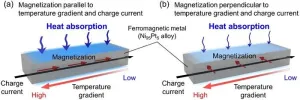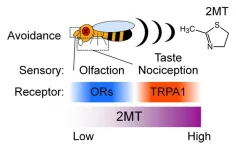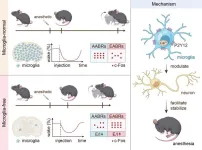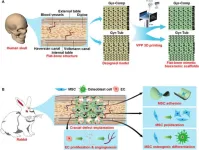(Press-News.org) For the first time, an instrument to find planets light years away was used on an object in the Solar System, in a study on Jupiter's winds.
We find ourselves at a time when it has become almost commonplace to discover planets orbiting another star, with more than 5,000 already registered. The first distant worlds to incorporate this list were mainly giant planets, similar to but also very different in many ways from Jupiter and Saturn.
Astrophysicists have already begun to obtain data on the atmospheres of exoplanets, but fundamental questions about the atmosphere of the largest planet in the Solar System are yet to be answered. To understand what happens in Jupiter’s clouds and air layers, it is necessary to study it over time, in continuous observations. Now, for the first time, an instrument developed to find and analyze worlds light years away, exoplanets, has been pointed at a target in the Solar System, 43 light minutes away from Earth: the planet Jupiter.
Researchers from the Institute of Astrophysics and Space Sciences (IA), at the Faculty of Sciences of the University of Lisbon (Portugal) (Ciências ULisboa), used the ESPRESSO spectrograph installed on the VLT telescope at the European Southern Observatory (ESO) to measure wind speeds on Jupiter. The results are now published in the scientific journal Universe.
The method that the team developed is called Doppler velocimetry and is based on the reflection of visible light from the Sun by clouds in the target planet’s atmosphere. This reflected light is bent in wavelength in proportion to the speed at which the clouds are moving relative to the telescope on Earth. This gives the instantaneous wind speed at the observed point.
The method now used with ESPRESSO was developed by the Planetary Systems research group of IA, with other spectrographs, to study the atmosphere of Venus. The researchers have been measuring the winds of this neighboring planet and have been contributing to the modelling of its general atmosphere for several years. Now, the exploratory application of this method with a “top of the range” instrument such as ESPRESSO has resulted in a success that opens new horizons to the knowledge of our cosmic neighborhood. This work affirms the feasibility of systematically monitoring the most distant atmospheres on gaseous planets.
For five hours, in July 2019, the team pointed the VLT telescope at the equatorial zone of Jupiter, where light clouds are located at a higher altitude, and at the north and south equatorial belts of this planet, which correspond to descending air and which it forms bands of dark, warmer clouds in a deeper layer of the atmosphere.
“Jupiter’s atmosphere, at the level of the clouds visible from Earth, contains ammonia, ammonium hydrosulfide and water, which form the distinct red and white bands”, says Pedro Machado, from IA and Ciências ULisboa, “The upper clouds, located in the pressure zone of 0.6 to 0.9 bars, are made of ammonia ice. Water clouds form the densest, lowest layer, and have the strongest influence on the dynamics of the atmosphere”, adds the researcher.
With ESPRESSO, the team was able to measure winds on Jupiter from 60 to 428 km/h with an uncertainty of less than 36 km/h. These observations, applied with a high-resolution instrument to a gaseous planet, have their challenges: “One of the difficulties centered on ‘navigation’ over Jupiter’s disk, that is, knowing exactly which point on the planet’s disk we were pointing to, due to the enormous resolution of the VLT telescope”, explains Pedro Machado.
“In the research itself, the difficulty was related to the fact that we were determining winds with an accuracy of a few meters per second when Jupiter’s rotation is on the order of ten kilometers per second at the equator and, to complicate matters, because it is a gaseous planet, and not a rigid body, it rotates at different speeds depending on the latitude of the point we observe”, adds the researcher.
To verify the effectiveness of Doppler velocimetry from telescopes on Earth in measuring winds on Jupiter, the team also gathered measurements obtained in the past in order to compare the results. Most of the existing data was collected by instruments in space and used a different method, which consists of obtaining average values of wind speed by following cloud patterns in images captured at nearby times.
The consistency between this history and the values measured in the study now published confirms the feasibility of implementing Doppler velocimetry in a program for monitoring Jupiter’s winds from Earth.
The monitoring will allow the research team to collect data on how winds change over time and will be essential for developing a reliable model for the global circulation of Jupiter’s atmosphere. This computational model should reproduce the differences in winds depending on latitude, as well as Jupiter’s storms, to help understand the causes of the atmospheric phenomena we observe on this planet. Conversely, the model will help prepare future observations with information about the pressure and altitude of the clouds in telescope’s sights.
The team intends to extend observations with ESPRESSO to a greater coverage of planet Jupiter’s disk, as well as temporally, collecting wind data throughout the planet’s entire rotation period, which is almost 10 hours. Restricting observations to certain ranges of wavelengths will also make it possible to measure winds at different altitudes, thus obtaining information on the vertical transport of air layers.
Once the technique has been mastered for the largest planet in the Solar System, the team hopes to apply it to the atmospheres of other gaseous planets, with Saturn as the next target. The success of these observations with ESPRESSO proves to be important at a time when its successor, ANDES, is being designed for the future Extremely Large Telescope (ELT), also from ESO and currently under construction in Chile, but also the future JUICE mission, from the European Space Agency, dedicated to Jupiter and which will provide additional data.
END
Jupiter was targeted by exoplanet hunter
2023-12-22
ELSE PRESS RELEASES FROM THIS DATE:
Pandemic lessons: Insights into how mobility restrictions affect healthcare costs
2023-12-22
Osaka, Japan - As the world grappled with lockdowns and restrictions brought by the COVID-19 pandemic, researchers at Osaka Metropolitan University conducted an extensive study to elucidate the link between changes in human mobility and the impact on medical costs associated with lifestyle-related diseases.
Dr. Haruka Kato and Professor Atsushi Takizawa of the Graduate School of Human Life and Ecology at Osaka Metropolitan University were concerned by the negative health effects resulting from the restriction of ...
Controlling thermoelectric conversion in magnetic materials by magnetization direction
2023-12-22
1. NIMS has succeeded in directly observing the "anisotropic magneto-Thomson effect," a phenomenon in which the heat absorption/release proportional to an applied temperature difference and charge current (i.e., Thomson effect) changes anisotropically depending on the magnetization direction in magnetic materials. This research is expected to lead to further development of basic physics and materials science related to the fusion area of thermoelectrics and spintronics, as well as to development of new functionalities to control thermal energy with magnetism.
2. The Thomson effect has long been known as one of the fundamental ...
Stinky, bitter, and painful: A novel insect repellent attacks multiple sensory pathways
2023-12-22
Okazaki, Japan – crop damage in agriculture and the transmission of vector-borne diseases by insect pests have become worldwide threat nowadays. Chemical treatments such as insecticides and repellents have been a major strategy against insect pests for centuries. Due to limited understanding of mechanisms of insect avoidance behavior, however, development of insect repellents has been delayed. To discover compounds that effectively repel insect pests, it is important to focus on key molecules associated with sensory, particularly aversive, responses. In this study, researchers ...
Microglia act as a “facilitator and stabilizer” for anesthesia
2023-12-22
Though it may be a surprise to the millions of people who undergo general anesthesia every year for medical procedures, the biological mechanism for how different anesthetics block consciousness is still not fully understood. However, researchers may be one step closer after uncovering the way small immune cells in the brain called microglia are impacted by general anesthesia.
The research was presented in a paper published in eLife on 22/Dec/2023.
“We found that microglia play an important role in regulating the body’s response to general anesthesia. ...
3D-printed flat-bone-mimetic bioceramic scaffolds for cranial restoration
2023-12-22
The cranial bone in the human body performs very important functions, such as protecting the brain and enabling the passage of the cranial nerves that are essential to physiological functioning. Critical-sized cranial defects can disrupt both the physical and psychological well-being of patients. Restoration of critical-sized cranial defects by cranioplasty is challenging for reconstructive surgeons, who prefer to use autologous bone grafts. The acquisition of autologous bone requires additional surgeries concomitant with risks such as free flap loss, infection, deep venous thrombosis, and nerve injury. These limitations necessitate the development ...
TTUHSC's Reddy elected fellow by the National Academy of Inventors
2023-12-22
P. Hemachandra Reddy, Ph.D., a professor in the Texas Tech University Health Sciences Center (TTUHSC) School of Medicine’s Department of Internal Medicine who has researched healthy aging, dementia and other neurodegenerative diseases for more than 20 years, recently was named to the 2023 class of Fellows for the National Academy of Inventors (NAI).
The NAI is a member organization comprised of U.S. and international universities and governmental and nonprofit research institutes with more than 4,600 individual inventor members and fellows spanning more than 300 institutions worldwide. ...
Light colour is less important for the internal clock than originally thought
2023-12-22
Vision is a complex process. The visual perception of the environment is created by a combination of different wavelengths of light, which are decoded as colours and brightness in the brain. Photoreceptors in the retina first convert the light into electrical impulses: with sufficient light, the cones enable sharp, detailed, and coloured vision. Rods only contribute to vision in low light conditions allowing for different shades of grey to be distinguished but leaving vision much less precise. The electrical nerve impulses are finally transmitted to ganglion cells in the retina and then via the optic nerve to the visual cortex in the ...
Scientists develop ‘flying dragon’ robot to fight fires from a distance
2023-12-22
Imagine a flying dragon that doesn’t spout fire, but instead extinguishes it with blasts of water. Thanks to a team of Japanese researchers, this new kind of beast may soon be recruited to firefighter teams around the world, to help put out fires that are too dangerous for their human teammates to approach.
The blueprint of this novel firefighter robot, called the Dragon Firefighter, has now been published in Frontiers in Robotics and AI. And as it has been published as Open Science, roboticists around the world may freely ...
Sunday sales reign supreme and other takeaways from review of farmers market transactions
2023-12-21
CORNELL UNIVERSITY MEDIA RELATIONS OFFICE
FOR RELEASE: Dec. 21, 2023
Kaitlyn Serrao
607-882-1140
kms465@cornell.edu
ITHACA, N.Y. – Cornell researchers partnered with New York livestock farmers to analyze transactions at farmers markets, finding that sales were better on Sundays, early in the morning, and during certain months of the year. The study, which researchers believe is the first peer-reviewed analysis of customer-level transaction data at farmers markets, gives new insights into how farmers can make markets more profitable for them.
The researchers and farmers used point-of-sale devices that record sales ...
Palliative care is underused for patients with malignant urinary obstruction
2023-12-21
Less than half of patients with malignant ureteral obstruction (MUO) – a serious complication of advanced cancer, with a poor prognosis – receive palliative care (PC) for their condition, reports a paper in the January issue of Urology Practice®, an Official Journal of the American Urological Association (AUA). The journal is published in the Lippincott portfolio by Wolters Kluwer.
Hospice care can promote patient comfort while avoiding aggressive and invasive treatments for MUO patients nearing the end ...
